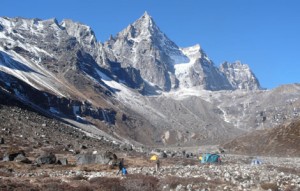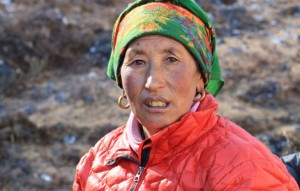That Yeti Attack On A Sherpa Woman: UPDATE
Posted by: Loren Coleman on April 16th, 2011
UPDATE: See comment from A&E producer/writer, newly added, in the comment section below.
=====
Scratching my head about “Hunt For The Abominable Snowman”: Reconsidering that Yeti attack on a Sherpa woman…
Let us further critique “Hunt for the Abominable Snowman,” being rebroadcast often on National Geographic Channel. Specifically, one interview sticks out.
In National Geographic’s recent documentary, “Hunt for the Abominable Snowman,” (airing again on Sat Apr 9 6PM) there was a segment with a woman who said she had been attacked by a Yeti.
This Sherpa woman stated the Snowman came up from behind her, hit her on the head, and grabbed her neck. She also said the Yeti then killed some “cows” (yaks) and seemingly feeling like she conveyed the notion the Yeti sucked blood from the yaks.

This is the caption with the photograph from the new 2011 NatGeo doc:
“Remote and desolate Machermo Valley, site of Lhakpa Dorma’s ferocious attack in 1974. She was attacked by what she believes was a Yeti. She escaped with her life only by playing dead, the yaks she was herding were not so lucky.” © Atlantic Productions

NatGeo spelled her name “Lhakpa Dorma.” Others have spelled her name as “Lhakpa Doma Sherpa” or more often, as “Lhakpa Domani.”
Of course, I had seen this woman interviewed years ago, in documentaries in which I have also appeared, by History, A&E, and other organizations.
Her story seems to have changed. In the past, she once said the Yeti grabbed her hair. And broke the necks of the yaks. She formerly was rather meek, when she was younger, and her emotions less over the top. She never said anything about the yaks being drained of blood by the Yeti.
Was she performing for the camera? Had she become a crafted, practiced interviewee? Was it her translator? Was this created by this specific program’s spin on the details? Or had the woman elaborated and come up with a new version of her attack by a vampire-like or Chupacabras-like Abominable Snowman?
Let’s look more closely at this encounter, as it is used so often on these reality programs and documentaries.
The following is the result of an Internet search of how this story has been re-told in various ways:
“In 1974 it was reported in the Sunday Times that a 19 year old yak herder was assaulted by a 4 foot tall Yeti, which killed 5 of her yaks by twisting their horns. Nepali police, it is claimed, confirmed the act, and a photographer recorded footprints. The Sherpa lady who was attacked was called Lhakpa Domani. Some sources also claim her brother was knocked out. This was North East of the village of Machermo. This was in the North of Nepal, some miles south west of Everest. It was in the pasture of a mountain.”
“A Yeti was alleged to have attacked Lhakpa Domani in 1974 near Mount Everest. She described it as similar to a large ape, with further detail of high cheek bones. It was said to have picked her up and thrown her some distance, then attacked the yaks that she had been tending.” Source.
“Machermo is well known because in 1974 a Yeti supposedly attacked a Sherpa woman named Lhakpa Domani and killed three yaks.” Source.
“A Yeti was alleged to have attacked Lhakpa Domani in 1974 near Mount Everest. She described it as similar to a large ape-like creature with black and brown hair. It was said to have picked her up and thrown her some distance, then attacked the yaks that she had been tending. Her brother found her soon after, wounded and unconscious, but alive. Several nearby Yaks lay dead, half eaten. The Yeti’s footprints were all around them. No reason whatsoever could be found for the unprovoked attack.” Source.
“On the maps of the Khumbu Valley there is a notation at Machermo, ‘site of Yet attack in 1974, 3 yaks killed and woman thrown in stream.'” Source.
She was touched? Hair pulled? Neck grabbed? Was she thrown down? Thrown in a stream? Played dead? Or not? Her brother was injured? Not injured? Found her? There were three yak killed? Or was it five? Were they half-eaten? Merely killed? Their blood drank?
Most telling of all is that this was a small Yeti, from all indications, only 4 feet tall. Yet that significant detail is avoided in recent melodramatic re-creations and interviews.
http://www.youtube.com/watch?v=TYwO_k7vDmg
The 1974 Yeti attack is re-created on MonsterQuest; it starts at 3:10 on the above video.
It would be good to view the old A&E interview with Lhakpa Domani side by side with the new one from NatGeo. Can anyone find the old interview on tape or YouTube? I could not, easily, before going to British Columbia.
About Loren Coleman
Loren Coleman is one of the world’s leading cryptozoologists, some say “the” leading living cryptozoologist. Certainly, he is acknowledged as the current living American researcher and writer who has most popularized cryptozoology in the late 20th and early 21st centuries.
Starting his fieldwork and investigations in 1960, after traveling and trekking extensively in pursuit of cryptozoological mysteries, Coleman began writing to share his experiences in 1969. An honorary member of Ivan T. Sanderson’s Society for the Investigation of the Unexplained in the 1970s, Coleman has been bestowed with similar honorary memberships of the North Idaho College Cryptozoology Club in 1983, and in subsequent years, that of the British Columbia Scientific Cryptozoology Club, CryptoSafari International, and other international organizations. He was also a Life Member and Benefactor of the International Society of Cryptozoology (now-defunct).
Loren Coleman’s daily blog, as a member of the Cryptomundo Team, served as an ongoing avenue of communication for the ever-growing body of cryptozoo news from 2005 through 2013. He returned as an infrequent contributor beginning Halloween week of 2015.
Coleman is the founder in 2003, and current director of the International Cryptozoology Museum in Portland, Maine.










In the chapter VIII of his “Le peu abominables hommes-des-neiges” Heuvelmans reports the fable told by Lhakpa, including the particular of the bloodsucker yeti.
He was a dreamer, so he believed that this unlikely story was true and said that all the impossible details (according to Lhakpa the yeti’s feet were turned back), were due to the state of shock of the witness.
She’s probably getting paid for her interviews or simply enjoying the repeated spotlight. Like many memories hers has no doubt become tangled with stories she’s heard over the years and fantasy and fact have become inextricably entwined in her head.
Don’t think she said “Sucked the blood’ but ‘drank the blood’.
Then again I think she at this point is embellishing the story because she states she was knocked unconscious.
She did describe that the yak was ripped open and it was her brother who initially found her and reported it.
To late for necropsy but would be interested to know if the liver was missing.
I’ve sent a link in “contact us” to a You Tube upload from Arthur C. Clarke’s Mysterious World. That particular segment contains an interview with Lhakpa Domani. This old program is from 1980 or so.
I was the producer/writer for the A&E “Ancient Mysteries” episode titled “Search for the Abominable Snowman.” I tracked down an old copy and found the interview. We were told that her name was spelled “Lhakpa Dolma.” This is what she said in her interview (as translated by another Sherpa who was a consultant on the project):
“While herding livestock high up on the mountain slope, I heard a whistle. I thought it might be my older brother. Then I heard the ground shudder and there was this darkness right behind me. The creature held me by my clothing and hair from behind and tossed me into a stream. After killing three cows, it crossed the stream and walked off with a strange twisting motion and disappeared over the ridge.”
She shows scars on her neck from the attack – though there are no close-ups.
This was taped in 1997. There was no mention of bloodsucking. And oddly, in this version she claims she was conscious because she watched the creature walk away.
I don’t know if this clears anything up… or simply adds to the confusion. Curious viewers may note the show show also contains interviews with a somewhat darker-haired Loren Coleman.
If these people were attacked everything described here sound just like a bear attack. I also think of a bear when the one witness describes a 5 foot yeti. Bears are stealthy and are known to go to for the head the render the victim unconscious. Even the description of the yak injuries is consistent with a bear. It is possible the entire story was made up but if not I think a bear was the culprit. Of course this is just an opinion.
In one of his marvellous books Lyall Watson tells of a court witness in India who gave evidence in a trial that was abandoned. When it came to re-trial she again gave evidence, which the counsel was quick to point out was different from the evidence she had given before.
“Of course” she replied “I am a different person from who I was then.”
Makes sense to me.
The name Dolma meaning ‘goddess’ (Tara) is a very common name for girls. I think the name changes are just people spelling that name differently.
It’s correct transliteration into English would require noting the letter ‘ra’ subjoined to ‘ga’ and creating the sound ‘da’ (said sometimes with a slight r sound and sometimes not in my experience).
Combining varying levels of literacy in the sherpa populations with significant dialect differences amongst Tibetan speakers and I’m not at all surprised that the name is being spelled differently in English by different people.
Also, ‘ni’ is sometimes affixed to words to add emphasis but isn’t common and the translator could have thought that was part of her name. That could explain the ‘Domani’ variation.
The influence of the Chinese government over this area is a bigger reason to question this story for me. I know people who travel regularly through Tibet and Nepal for business and you don’t do much without a Chinese official knowing about it – even outside Tibet. The Chinese government is looking for ways to increase tourism in this area and and I see yeti wonderland parks in the future for this region.
I’m betting they asked her to embellish her story. I can’t see how anyone got permission to speak to her without going through them, but I’d love to know more about that side of it. I’m looking forward to watching these documentaries.